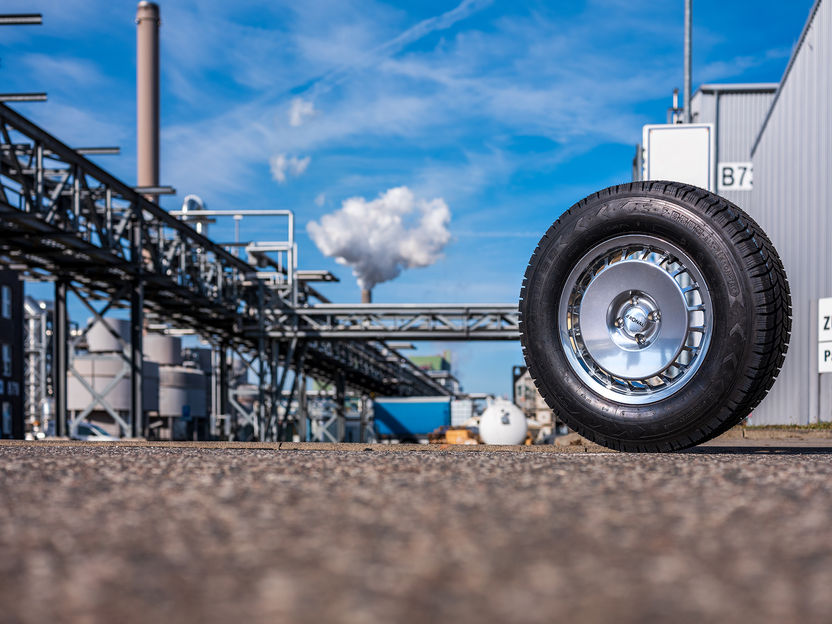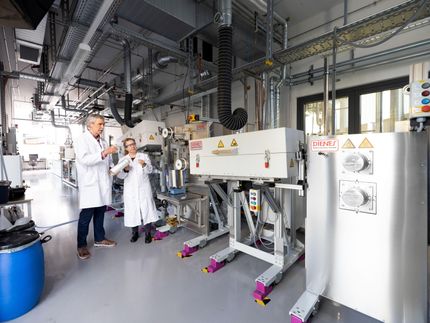Synthetic rubber outperforms natural rubber
Truck tires with less abrasion
natural rubber from rubber trees is a raw material with a limited supply. Synthetically produced rubber, on the other hand, has not yet been able to match the abrasion behavior of the natural product, rendering it unsuitable for truck tires. But now, for the first time, a new type of synthetic rubber has been developed that achieves 30 to 50 percent less abrasion than natural rubber.

Initial testing of tires made from the nature-identical, biomimetic synthetic rubber BISYKA shows that they achieve around 30 to 50 percent less abrasion compared to natural rubber tires.
© Fraunhofer IAP, photographer: Till Budde
Truck tires have to put up with a lot: As a result of the heavy loads they carry and the long distances they travel every day, they are subject to heavy wear and tear. Consequently, the treads of the tires are manufactured primarily from natural rubber that comes from rubber trees and to date has demonstrated the best abrasion characteristics. Before now, artificially manufactured rubber has been unable to match the performance of natural rubber, at least in this respect. The problem with natural rubber is that the security of supply for this important raw material is endangered. In Brazil, the original home of the rubber tree, the fungus Microcyclus ulei is laying waste to whole plantations. If the fungus crosses over to Asia, where major cultivation areas are located today, the global production of rubber will be threatened.
Biomimetic synthetic rubber with optimized abrasion behavior (BISYKA)
In view of this threat, researchers at the Fraunhofer Institutes for Applied Polymer Research IAP, for Microstructure of Materials and Systems IMWS, for Molecular Biology and Applied Ecology IME, for Mechanics of Materials IWM and for Silicate Research ISC have now optimized the characteristics of synthetic rubber. “Our synthetic rubber BISYKA – that’s a German abbreviation for “biomimetic synthetic rubber” – actually has superior characteristics to natural rubber,” says Dr. Ulrich Wendler, who heads up the project at the Fraunhofer Pilot Plant Center for Polymer Synthesis and Processing PAZ in the German municipality of Schkopau. Fraunhofer PAZ is a joint initiative between Fraunhofer IAP and Fraunhofer IMWS. “Tires made of the synthetic rubber lose 30 percent less mass than equivalent tires made of natural rubber. On top of that, the synthetic tires have only half the tread loss. Furthermore, the synthetic rubber can be produced on an industrial scale using existing plants and equipment. This means that the synthetic rubber offers an excellent alternative to natural rubber – including the domain of high-performance truck tires.”
Targeted analysis of dandelion rubber
But how did the researchers achieve this higher performance? At Fraunhofer IME, scientists investigated rubber from dandelions. Like the rubber from rubber trees, 95 percent of dandelion rubber consists of polyisoprene, while the remaining percentage is made up of organic components such as proteins or lipids. The advantage of dandelion rubber over tree rubber: the former has a generation succession of just three months as opposed to seven years for the latter. That makes rubber made from dandelions an ideal starting point for investigating the influence of organic components on the rubber characteristics. To this end, the Fraunhofer researchers eliminated the key organic components involved in a targeted manner. After they had identified the organic components that were important for abrasion behavior, the researchers at Fraunhofer IAP synthesized the BISYKA rubber out of functionalized polyisoprene with high microstructural purity and the respective biomolecules. Their colleagues at Fraunhofer IWM and IMWS then investigated the characteristics of the rubber variants thereby obtained. To do this, they used extensional crystallization: If you stretch natural rubber to three times its length, crystalline regions form – the rubber hardens. “The extensional crystallization of BISYKA rubber equals that of natural rubber,” explains Wendler. When making truck tires, the rubber is usually mixed with carbon black – which is where the black color comes from. Increasingly, however, manufacturers are adding silicates to the mixture instead of carbon black. This is where the expertise of Fraunhofer ISC comes in: At the institute, scientists investigate how new kinds of silica fillers can lead to optimum alternatives to natural rubber in the automotive industry.
Synthetic rubber yields impressive results in practical tests
After the development of the BISYKA rubber, it was tested: Would it do what its extensional crystallization promised? The researchers handed over this question to an external and thus independent partner to investigate: Prüflabor Nord. For this purpose, four car tires were manufactured with a tread made from BISYKA and they were then compared with tires with a tread made from natural rubber. The tests were carried out directly on a car that drove 700 circuits in one direction and then 700 circuits in the other direction. And the result? While the natural rubber tire was 850 grams lighter after the test and lost 0.94 millimeters of tread, the BISYKA tire lost merely 600 grams and 0.47 millimeters of tread. The rolling resistance of the synthetic rubber was also better: While the natural rubber achieved a score of C on the traffic light labelling of the rolling resistance, BISYKA achieved the higher score of B. “So far, we have only carried out initial tests with the BISYKA tire blend, but they are extremely promising. As the next step, we want to further optimize the BISYKA rubber. This concerns above all the proportion and the composition of the organic components. At the same time, we will adapt the formula of the tread compound for truck tires to the new rubber,” says Wendler. Currently the researcher and his team are looking for cooperation partners who will bring the product to the market.




















































